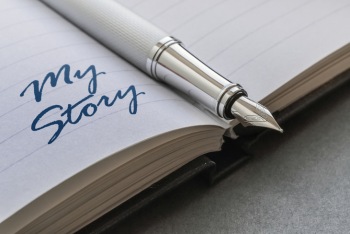by Mary Ellen Brennan, former member of AWC The Hague
 Although I had not had frequent attacks, there were clues that something was wrong with my gallbladder. The diagnosis was made by my primary care doctor, or huisarts, where most medical care in the Netherlands begins. After confirming gallstones were present using the ultrasound machine in his office, he referred me to the hospital for another ultrasound and an appointment with a surgeon. Surgery was recommended, but there was a four-month wait. I checked the waiting times (Wachttijden) at other hospitals in the province and beyond, but they were worse for this type of surgery.
Although I had not had frequent attacks, there were clues that something was wrong with my gallbladder. The diagnosis was made by my primary care doctor, or huisarts, where most medical care in the Netherlands begins. After confirming gallstones were present using the ultrasound machine in his office, he referred me to the hospital for another ultrasound and an appointment with a surgeon. Surgery was recommended, but there was a four-month wait. I checked the waiting times (Wachttijden) at other hospitals in the province and beyond, but they were worse for this type of surgery.
I began to experience constant discomfort and malaise. The hospital scheduled a call with the surgeon, and he decided to give me a higher priority because of my family history of gallbladder problems. Laparoscopic surgery was scheduled for about a month later.
Pre-Surgery
There wasn’t much preparation or pre-surgical testing involved – only some forms and a call with the anesthesia department. I was allowed to have some liquids, including orange juice, on the morning of surgery, because the surgery would be in the late morning.
Surgery
I was escorted to an area for outpatient surgeries. There wasn’t a private changing area, so I stood in front of my assigned locker, quickly undressed, and secured my things. After a short wait, I was wheeled to the pre-surgical area. They could not get an IV started, a problem I have never experienced before or after. Even after agreeing in the phone consult not to use my left arm because I have lymphedema, the nurse told me she was going to anyway. When I reminded her about the precautions, she replied, “we don’t believe that here.” That IV must have failed somewhere along the way because I awoke with the IV in the crook of my right elbow.
I was taken to the operating room and expected to get myself onto the operating table. Everyone spoke English to me and explained that they would speak Dutch to each other as they went through their protocol and checklists. After about five minutes, I was anesthetized.
Post-Surgery
I awakened to find the doctor and several others standing around me. He told me that he could not complete the surgery laparoscopically and had to do an open procedure. My gallbladder was severely inflamed, infected, and full of stones and polyps. He started me on IV antibiotics in the operating room and said I would remain in the hospital for three nights to complete them. Further, he had to insert a surgical drain.
When the surgeon made the rounds the next morning, he said that if I had not pressed for earlier scheduling, I would have ended up in the emergency room in great danger.
Hospital
Hospital rooms in the Netherlands usually house four to six patients of mixed gender, but this relatively new hospital had double rooms. I was assisted in getting up one time and then expected to get myself up and to the bathroom, carting my IV pole and drain along with me, even unplugging it from an outlet near the baseboard. My previous hospital experience helped me with this.
My first “roommate” was a man who had a hip replacement. As soon as he demonstrated going up and down from a step, he was discharged. My second roomie was a woman who had had gynecological surgery. She was up and dressed early and left. The third night, I was alone.
Nursing Care
The first evening after surgery, I lost consciousness in the bathroom. I pulled the emergency cord right before, and I believe the nursing staff was there in seconds. In hindsight, as I knew more about the antibiotic, I realized the dizziness and nausea were due to it. The nursing staff came quickly whenever I called and provided excellent care.
Pain Relief
I only recall receiving IV pain medication in the recovery room. I was given pain pills the day after the surgery. Then, I was switched to the Dutch favorite, paracetamol (Tylenol). I asked for acetaminophen (Advil), but I only received an order for a day. The Dutch believe it is harmful to the stomach. The doctor did not order any prescriptions for home.
Food
After awakening from anesthesia, I was given a pear popsicle, a flavor that was hard to identify but became a favorite. I thought I should resume eating a modified diet, but was told the Dutch don’t believe it’s necessary. I was given choices from a menu of Dutch and Indonesian food. I tried the “brood” meal – a meal of bread and cheese that the Dutch usually eat once daily – but found it too difficult to chew with a dry mouth. By the fourth day, I finally got a nurse to bring me a bouillon cube in hot water. When the surgeon on call saw it, he told the nurse to throw it out. Generally, the food quality was very good.
Clothing
The surgeon on call also proclaimed that I needed to wear my own clothes. I wondered why my Dutch friend had brought so many clothes to the hospital, but I did not realize that I was supposed to wear them during my hospital stay. With a drain and an IV, that would have been a bit challenging.
Leaving the Hospital
On the fourth day, my antibiotic treatment was completed, and I finally began to feel better. When a friend visited, I asked if I could leave the hospital with her. The doctor had left a discharge order, but no one told me. No one seemed to care when I left the hospital.
Cost
The Netherlands health insurance scheme is a public plan operated by private companies. Under the plan, no one is at risk for more than €385 of eligible medical expenses. Having met most of my deductible, I paid a small amount – so small that I cannot remember what it was.
Read about my second European surgery experience in Portugal.
